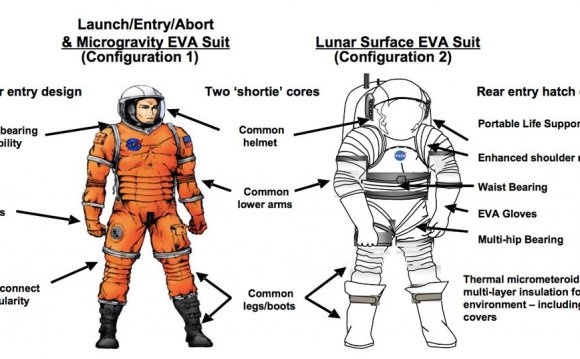
Astronauts wear various types of clothing for all aspects of a mission to space. Whether preparing for launch, working inside the space shuttle or the space station, working outside in space, or landing back on Earth, astronauts wear the proper garments for both comfort and protection.
Space Station Clothing
International Space Station crewmembers choose the shirts, shorts and pants they will wear in space months before they are scheduled to launch. In fact, their clothes often arrive at the space station before they do, via a Progress resupply vehicle or a space shuttle.
|
Click an image to see the different outfits astronauts wear. Space station crews can choose from either Russian or U.S. clothing supplies. They also have the option of ordering two versions of Russian coveralls - heavy or light-duty - to work in aboard the space station. Because it's expensive to take supplies into space and there's no washing machine aboard the space station - in order to save water - station crews don't change clothes as often as people do on Earth. Of course, since they don't go outside, except in a spacesuit, they don't get as dirty as people living on Earth. They're also able to bathe every day and after exercising. The Expedition Six commander, Ken Bowersox, did find a way to wash his favorite pair of shorts, however (see the video section at right). On average, station crewmembers get one pair of shorts and a T-shirt for every three days of exercising. Their work shirts and pants/shorts are changed, on average, once every 10 days. Crewmembers generally get a new T-shirt to wear under their work shirts every 10 days. Underwear and socks are changed every other day, but PolartecTM socks, which are worn if a crewmember's feet get cold, must last a month. They also get two sweaters. In addition, each crewmember gets a pair of running shoes to use on the station's treadmill and another pair of shoes to wear when using the station's exercise bicycle. When a piece of clothing has been worn as many times as possible, it's placed in a bag for disposal. Very little clothing is brought home by space station crewmembers. Most of it is eventually placed in the Progress resupply vehicle before it undocks from the space station. The dirty clothing and other garbage then burns up with the Progress when it re-enters the Earth's atmosphere. Space Shuttle Clothing Like space station crewmembers, shuttle astronauts choose their clothing months before their launch, often selecting tops that have their mission's logo sewn on them. Unlike space station crewmembers, however, shuttle astronauts bring a change of clothes for every day of their mission. Click image to see the different outfits astronauts wear. Space shuttle crewmembers can choose to wear pants or shorts depending on what they're doing aboard the shuttle and the temperature inside the spacecraft. They also have the option of wearing long- or short-sleeve polo shirts or rugby shirts, as well as sweaters and pullovers. Like space station crews, shuttle astronauts wear shorts and T-shirts when they exercise. The pants they wear are covered with plenty of pockets and velcro. The pockets and velcro help them keep everything they're working with near them. Without gravity, anything a person lets go of will float away - to be found later on the filtering screen of the shuttle's air circulation system. This screen is the shuttle's version of the Lost and Found section. Station crewmembers also report finding their lost items on the screens of the space station's air circulation system. Launch and Landing During launch and entry aboard a space shuttle, crew members use the orange Launch and Entry Suits you see astronauts wearing as they walk out to the launch pad at the Kennedy Space Center in Florida. In the event of a pressure leak in the space shuttle's flight cabin, the suits would maintain a positive air pressure around the astronaut. This provides enough air pressure for the astronaut to survive the return to Earth during an emergency landing. Should an astronaut be forced to bail out over cold water, the pressurized suit would also provide thermal protection. The LES, as it is called, provides an emergency oxygen system; parachute harness; parachute pack with automatic opener, pilot chute, drogue chute and main canopy; a life raft; two liters of emergency drinking water; flotation devices; and survival vest pockets containing a radio/beacon, signal mirror, shroud cutter, pen gun flare kit, sea dye marker, smoke flare and beacon. The attached parachute can be opened automatically or manually. |
RELATED VIDEO












